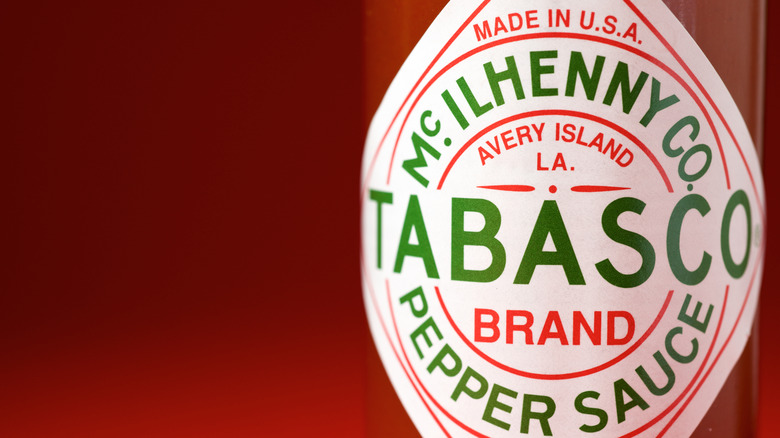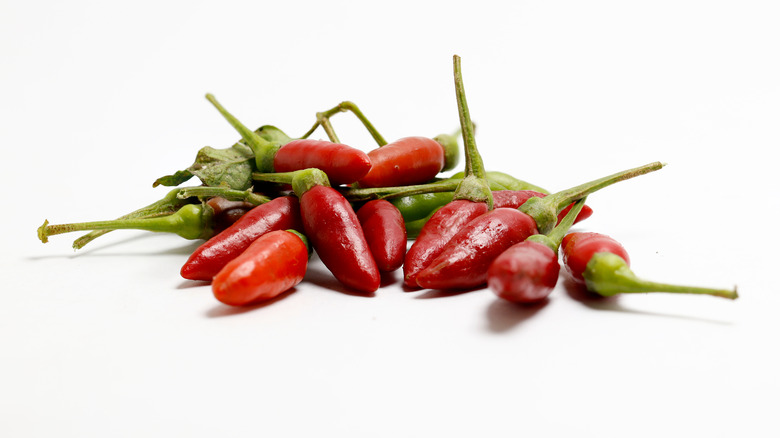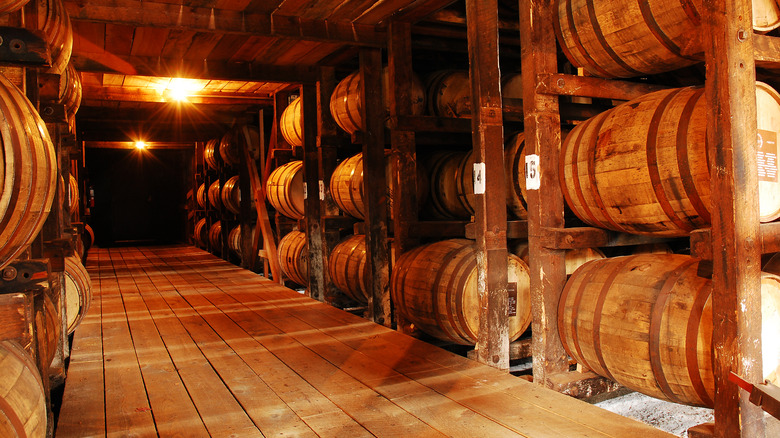The Surprising Connection Between Bourbon And Tabasco
What do bourbon and Tabasco have in common? Let's see. They're both liquid. They're both produced in the southern United States. They both boast ardent fan bases. Surprising? Not so much. There's another, lesser-known connection that may shock whiskey and hot sauce lovers alike. Tabasco is aged exclusively in used bourbon barrels (via Atlanta Magazine).
Developed in 1868 by Edmund McIlhenny, Tabasco is still produced where it originated, on Avery Island, Louisiana, and McIlhenny's descendants remain an integral part of day-to-day operations. As reported in the Acadiana Advocate, McIlhenny's great-great-grandson, Harold Osborn, assumed the role of CEO and president in 2019. These days, you'll find Tabasco in almost 200 countries worldwide. It even blasted into space in the 1970s, packed to give a little zing to astronauts' freeze-dried rations. But the red pepper seeds at the heart of the original recipe are still grown and harvested on Avery Island (via Southern Living).
Tabasco uses seeds from frutescens peppers, part of the Capsicum family
Tabasco lists just three ingredients on its label: distilled vinegar, red peppers, and salt. The FDA requires U.S. manufacturers to list ingredients in order of predominance, so we can assume McIlhenny's original recipe (still in use today) is vinegar-based. Beyond that, it's difficult to replicate. Pepper Scale did a little digging. Turns out McIlhenny created Tabasco using seeds from frutescens peppers, part of the Capsicum family. The Scoville heat unit rating for that particular variety is 30,000 to 50,000, making them anywhere from four to 20 times hotter than jalapeño peppers (also part of the Capsicum family), but the finished product is much milder, about 2,500 to 5,000 SHUs. Vinegar and the aging process reduce the heat factor in the final product.
For its first 30-plus years, McIlhenny Company aged its pepper mash in stoneware jars. Sometime around 1900, the company switched to aging in white oak barrels. While the reasoning has been lost to history, the white oak barrels have become an integral part of aging process, an essential step for more than 120 years (via Vine Pair).
Tabasco is aged in used bourbon barrels
A post on The McIlhenny Company blog names the white oak barrels the "unsung heroes of the aging process." Blending manager Coy Boutte says the company sources barrels from bourbon distilleries across the United States. There's a ready supply because, by law, every batch of bourbon must age in new oak barrels (via Angel's Envy) which are charred prior to use. It's the oak and the charring that give bourbon its distinctive color and flavor.
American's Best Racing, a multimedia fan development and awareness-building platform affiliated with The Jockey Club, says despite the connection, you won't find hints of bourbon in your Tabasco. That's because the barrels are scrubbed and sweated before they're ready to nurture the pepper mash. The process removes any traces of alcohol still in the wood. The pepper mash ages in the barrels for up to three years (via McIlhenny Company) before it's blended with distilled vinegar, strained, and bottled.
So what happens to the unsung heroes of the Tabasco-making process? Boutte says the white oak barrels are used again and again, with a few in the warehouse in the range of 80 to 90 years old. Average lifetime, though, is 35 to 40 years (about 15 to 20 batches). After that? Tabasco wood chips.


